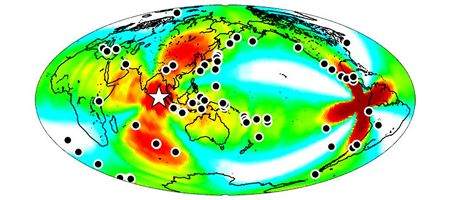Very large earthquakes like last April’s Sumatra quake can set off others around the world for at least a week, including one as far away as Baja California.

The Sumatra quake, a magnitude 8.6 temblor, did little damage, but was the tenth largest in the last 100 years. Like some other recent large quakes, it triggered small quakes during the three hours it took for seismic waves to travel through the Earth’s crust.
But according to seismologists from the University of California, Berkeley, and the US Geological Survey (USGS), it had longer-term effects too, triffering some faults to break up six days later.
Indeed, the team found five times the expected number of quakes during the six days following the April 11 quake and aftershock.
“Until now, we seismologists have always said, ‘Don’t worry about distant earthquakes triggering local quakes,” says Roland Burgmann, professor of earth and planetary science at UC Berkeley.
“This study now says that, while it is very rare – it may only happen every few decades – it is a real possibility if the right kind of earthquake happens.”
The effects were seen as far away as Indonesia, Japan, and Baja California, where there was a 7.0 quake.
“We found a lot of big events around the world, including a 7.0 quake in Baja California and quakes in Indonesia and Japan, that created significant local shaking,” Burgmann added. “If those quakes had been in an urban area, it could potentially have been disastrous.”
The reason the Sumatra quake had this effect when others didn’t is, says the team, because the East Indian Ocean quake was a ‘strike-slip’ quake, which generates waves, called Love waves, that travel just under the surface and are energetic enough to affect distant fault zones.
It’s possible that the quake triggered a cascade of smaller, undetectable quakes on local faults that led to larger ruptures later on. Alternatively, it may have triggered tiny microquakes, indicating slow slip underground.
“One possibility is that the earthquake immediately triggers slow slip in some places, maybe accompanied by detectable tremor, and then that runs away into a bigger earthquake,” says Burgmann. “Some slow slip events take days to a week or more to evolve.”






